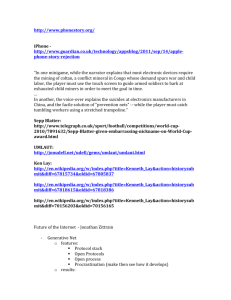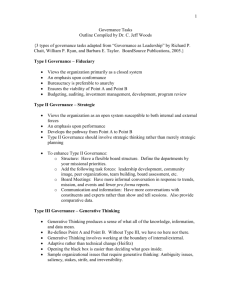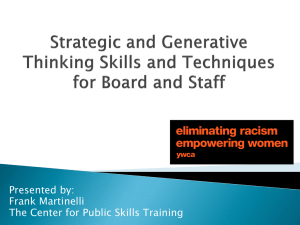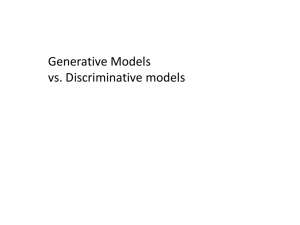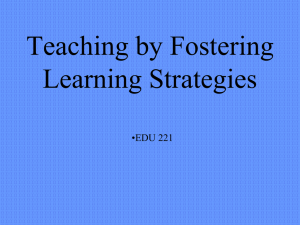Creative Partnerships with Technology: How Creativity Is Enhanced through Interactions
advertisement
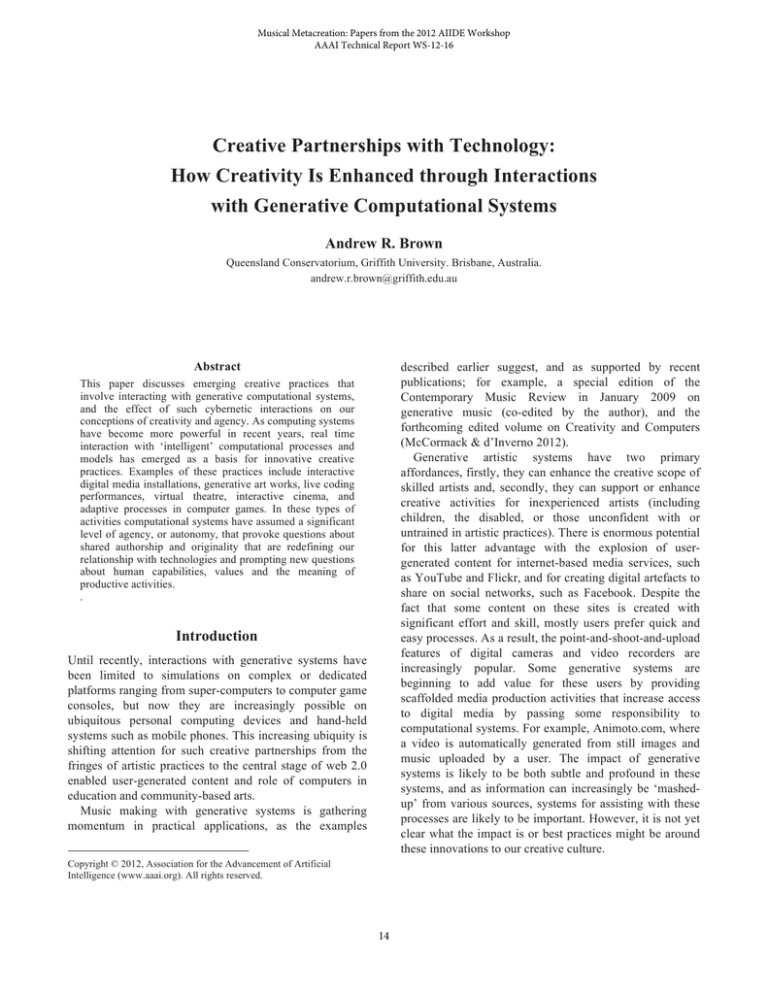
Musical Metacreation: Papers from the 2012 AIIDE Workshop AAAI Technical Report WS-12-16 Creative Partnerships with Technology: How Creativity Is Enhanced through Interactions with Generative Computational Systems Andrew R. Brown Queensland Conservatorium, Griffith University. Brisbane, Australia. andrew.r.brown@griffith.edu.au Abstract described earlier suggest, and as supported by recent publications; for example, a special edition of the Contemporary Music Review in January 2009 on generative music (co-edited by the author), and the forthcoming edited volume on Creativity and Computers (McCormack & d’Inverno 2012). Generative artistic systems have two primary affordances, firstly, they can enhance the creative scope of skilled artists and, secondly, they can support or enhance creative activities for inexperienced artists (including children, the disabled, or those unconfident with or untrained in artistic practices). There is enormous potential for this latter advantage with the explosion of usergenerated content for internet-based media services, such as YouTube and Flickr, and for creating digital artefacts to share on social networks, such as Facebook. Despite the fact that some content on these sites is created with significant effort and skill, mostly users prefer quick and easy processes. As a result, the point-and-shoot-and-upload features of digital cameras and video recorders are increasingly popular. Some generative systems are beginning to add value for these users by providing scaffolded media production activities that increase access to digital media by passing some responsibility to computational systems. For example, Animoto.com, where a video is automatically generated from still images and music uploaded by a user. The impact of generative systems is likely to be both subtle and profound in these systems, and as information can increasingly be ‘mashedup’ from various sources, systems for assisting with these processes are likely to be important. However, it is not yet clear what the impact is or best practices might be around these innovations to our creative culture. This paper discusses emerging creative practices that involve interacting with generative computational systems, and the effect of such cybernetic interactions on our conceptions of creativity and agency. As computing systems have become more powerful in recent years, real time interaction with ‘intelligent’ computational processes and models has emerged as a basis for innovative creative practices. Examples of these practices include interactive digital media installations, generative art works, live coding performances, virtual theatre, interactive cinema, and adaptive processes in computer games. In these types of activities computational systems have assumed a significant level of agency, or autonomy, that provoke questions about shared authorship and originality that are redefining our relationship with technologies and prompting new questions about human capabilities, values and the meaning of productive activities. . Introduction1 Until recently, interactions with generative systems have been limited to simulations on complex or dedicated platforms ranging from super-computers to computer game consoles, but now they are increasingly possible on ubiquitous personal computing devices and hand-held systems such as mobile phones. This increasing ubiquity is shifting attention for such creative partnerships from the fringes of artistic practices to the central stage of web 2.0 enabled user-generated content and role of computers in education and community-based arts. Music making with generative systems is gathering momentum in practical applications, as the examples Copyright © 2012, Association for the Advancement of Artificial Intelligence (www.aaai.org). All rights reserved. 14 The conceptual roots of generative systems and creativity run deep (Weizenbaum 1976; Papert 1980; Holland 1998; Shneiderman 2003; Baum 2004) and their impact on human relationships with technologies (and therefore reflection on their own productive value) will be significant; not unlike the reflection and change required when industrial automation transformed working and cultural practices over 100 years ago (Levenson 1994). Interactions with generative computational systems will likely have a similar effect on intellectual work over the next few decades, with the impact on creative practice being one important indicator of that change. interactive improvisation including The Continuator (Pachet 2002; 2010) and OMax (Assayag, Bloch, Chemillier, Cont and Dubnov 2006). Outside of music there are many other examples, particularly in visual arts, where prominent generative artists include Ernest Edmonds, Jon McCormack, and Christa Sommerer & Laurent Mignonneau. Further examples in these fields and beyond, including generative architectures and robotics are detailed in other places, such as in the book Creative Evolutionary Systems (Bently and Corne 2002). This paper will use music as a primary case of creative activity and discuss interactive musical partnerships with computing systems. There are several reasons for focusing on music. First, it is the author’s home discipline facilitating deep and authoritative insights; second, music is, along with the other arts, a paradigmatic arena for creativity and poetics; and third, music is a discipline that has been closely associated with utilizing technical developments to expand its expressive options. In the words of Arnold Pacey who, in his book Meaning in Technology, states that in music “human relationships and human purposes may have a closer connection with technological progress than sometimes seems possible” (1999:38). In the digital arena generative processes have been used in computer music from its earliest days, for example in the composition of the Iliac Suite (Hiller and Isaacson 1958). For our purposes here, parallels can be drawn between fluid experiences with computing technologies with experiences of performing with acoustic musical instruments. Interacting with a generative music system is a novel case of mediated experience with music, and an open question is to what extent this fluidity of experience is possible and under what conditions can it be maintained. With generative systems sound production is ongoing, whereas with traditional musical instruments sound lasts only during excitation through gesture. However, digital interaction with music goes further these days according to Marc Leman in his book, Embodied Music Cognition and Mediation Technologies. Leman suggests that there is a “unique role of technology with respect to music: that access to music nowadays proceeds via digital technology. This is the case in music production, music description, and music consumption” (Leman 2008:22). In generative systems, interaction is often archived through variation of algorithm parameters or abstract structures. Such metacontrols, McCullough suggests, “require mediation between action and notation” (McCullough 1996:115). This is particularly true of computers where notation, in the form of computer code, specifies opportunities for action, including changing the code itself as in live coding performances (Brown 2006). Background The particular focus of this paper is human interaction with real time generative computational systems as used for the creation of artistic works. There are a range of uses for the term ‘generative’ so it is useful to be clear about how it is used here. A well established use of the term is for generative theories where a theory or model is predictive or productive of outputs based on rules. Examples include Chomsky’s generative grammar in linguistics, Lerdahl and Jackendoff’s Generative Theory of Tonal Music (GTTM) in music analysis (Lerdahl and Jackendoff 1983), and Sloboda’s Generative Processes in Music in the field of music psychology (Sloboda 1988). In computing there is the field of generative systems, in which autonomous computational processes or models are set in motion, generally free of interaction. Commonly these exist as simulations or models of physical process, and they have been used for artistic works based on artificial life, for example. A related computing term is genetic programming, used to describe the construction of computer programs through automated evolutionary processes; that is, programs that write programs. The commonality in both computing cases is an objective of generative applications to produce novel output with some autonomy, and a strong commitment to ideas of evolution and emergence. For the purposes of clarity, following are a number of examples of interactive generative digital media works that typify the creative activity central to the types of creative partnerships of interest in this paper. Musical examples include those from the well known musician Brian Eno, in particular his album Generative Music (Eno 1996) distributed as personal computer software and, more recently, his iPhone applications including Bloom, Trope and Air (Eno and Chilvers 2008). Eno was also the musical ‘composer’ for the generative music soundtrack to the Spore computer game (Electronic_Arts 2008). Other music examples include Karlheinz Essl’s Lexikon Sonate (Essl 1992) and his online interactive works, and systems for 15 computational media research networks including, Live Algorithmic Music (LAM), the live coding collective TOPLAP, the digital arts group at generative.net, and more. Generative systems have also made inroads into design fields including computer-aided design (CAD) for manufacturing and algorithmic architecture (Frazer 1995; Terzidis 2006). These latter systems, as with most innovations in practices, tend to be used by professionals who are seeking new methods of expressions and willing to learn to master new (often unreliable) techniques and applications. Digital Art Practices Live Coding is a cutting-edge, and interesting, case. More conventional forms of user interaction with generative systems include gestural control over continuous parameters and toggled settings, either though a graphical user interface, attached hardware controller, or audio/visual input. Such interactive options for musical applications are well documented in the literature, including in the proceedings of the annual New Interfaces for Musical Expression (NIME) conferences. Computational systems that are interactive in this way have been termed hyperinstruments by Tod Machover, and as Beilhartz and Ferguson point out “for a hyper instrument it is integral to the augmentation of musical performance that the generative processes respond in a sympathetic, symbiotic, collaborative way” (2007:213). Leman (2008) details the psychological issues of gestural and perceptual interaction with acoustic instruments and computational musical systems. The practice of interacting musically with generative systems has been termed hyperimprovisation by Dean (2003), a term that reflects an exploratory and performative (improvisational) approach. My own research builds on the work about hyper-instruments and hyperimprovisation but, rather than focussing primarily on either instrument making or performance practices, it explores interactive experience and the effects on creative productivity (Brown and Dillon 2012). The potential for computational creativity did not escape even the earliest designers of the computer, notably Alan Turing, and this fascination lead to the establishment of the field of artificial intelligence. In part, because of the limited success of fully autonomous AI and also in part because of the increased access to computing tools by artists and designers, experiments with creative partnerships between artists and computing systems developed. Landmarks in these developments include David Cope’s EMI (Cope 1996) system for music composition and Harold Cohen’s Aaron (Clancey 1997) system for visual art drawings. Generative simulation systems (Berry 1997; Brown, Wooller and Miranda 2011) and real time interactive systems (Rowe 1993) appeared in the later quarter of the 20th century. Soon after, these processes made their way into popular culture in a number of forms, including Brian Eno’s interactive music productions (Eno 1996), Toshio Iwai’s computer game systems (Iwai 2005), and more recently The Sims and Spore computer games from Electronic Arts and in Computer Generated Interaction (CGI) systems for feature film and digital animation. Generative processes are prominent in current digital art practices, including in the works of Maeda (2004), Reas (2006) and the live coding practices of Alex McLean (2004) and Andrew Sorensen (2005). These practices are drawn together in informal Intellectual Deliberations Explorations into creative partnerships with technology build on the examination of human uses of technology that has been a theme permeating studies in anthropology, at least since the work of Lévi-Strauss (Levi-Strauss 1966; Wiseman 2007), and of philosophy, at least since Plato. The anthropological perspective, which was adopted by social science and media studies critics, looked at computers as an artefact in a social context; all be it one with unprecedented capability. Indicative of this trend, McLuhan famously described all media as extensions of human capacities (McLuhan 1964). This kind of humanistic approach to computer usage is echoed in the works of Agre (1997) from an AI perspective, Hickman (1990) from the point of view of Dewey’s pragmatism, and Clancey (1997) drawing insights from the evolutionary psychology of Brunswick and Gibson. I suggest that we can fruitfully embrace the notions of embodiment and situatedness and should explore the human-computer partnership as a functional system rather than as a relational dialog. The phenomenology of technological interaction, which is of particular interest for this paper, gained direct attention in the work of Heidegger (1977), and has been extended by Dreyfus (1979), Borgman (1984), Ihde (1990), Coyne (1994), Feenberg (1999) and others. Coyne suggests that we adopt a hermeneutical perspective that rises above considerations of control and that we examine the application of technology acknowledging “the desire of humankind toward praxis and community” (1995:91). Hickman suggests, after Dewey, that we embrace a “productive pragmatism” with a focus on technology as inquiry involving new ways of “feeling and seeing” (2001:181) and achieve this through the active development of new tools for solving practical problems. In relation to digital systems, a similar experiential approach is outlined by McCullough who states that “instead of working with a computer, you might want a chance to feel that you are working through it—with other people, with your work, in your work” (1996:114). 16 Norman makes a related point from the perspective of design psychology in his book The Invisible Computer (1998). One of the clearest articulations of this phenomenological perspective on tool use is that of Winograd and Flores (1986) who, in the wake of a rethink about artificial intelligence, connected phenomenological perspectives with a situated and contextual view of agency from biology to articulate revised lines of inquiry for human activities with semi-autonomous computing machines. They propose that “The relevant questions are not those comparing computers to people, but those opening up a potential for computers that play a meaningful role in human life and work” (1986:12). It is in this spirit that my own research seeks to better understand the emerging potential of generative computation in the creative arts. creative engagements are possible with generative computing systems; that they reveal, rather than close down, opportunities for new and meaningful work. They also raise many questions about how this work is understood by the participants and by audiences, and how work utilizing generative systems can challenge existing social expectations and ways of operating, including (re)defining arts forms, working processes, legal definitions, methods of reception and distribution, and function of the arts and artists in societies. Paying attention to creative experience reveals a range of interesting issues including abstraction, metaphor, representation, attention, and gesture, each of which has their own raft of considerations and details. In particular, previous work in interactive computer systems has shown that the way things are presented or understood is critical. As Laurel states in her study on computers as theatre, “knowing what is going on in this representation is ultimately more important than knowing what is going on in the computer itself” (Laurel 1991). McCullough advises that dynamic control over high level operations rather than low level details yields a sense of control over a complete process in tool usage generally. This kind of meta-control is typical of manipulating generative processes. In a similar vein, Beilhartz and Ferguson argue that the experience of connection and control for generative music systems is critical; “The significance of generative processes in an interactive music system are their capability for producing both a responsive, strict relationship between gesture and its auditory mapping while developing an evolving artefact that is neither repetitive nor predictable, harnessing the creative potential of emergent structures” (2007:214). These and other issues of experience design for generative creative systems need to be canvassed and can build on established theories of creativity and interaction. Generative Computation and Creativity It has in recent years become common to attribute many people and activities with creativity, particularly since the articulation of a creative class (Florida 2002) and since the economic arguments for the importance of creative industries have become more prominent. However, the arts and design disciplines still remain particularly reliant on creativity and, as such, are a relevant focus for research into creativity. Creativity is associated with originality, insight and innovation and some nuanced definitions and descriptions have been provided by psychologists such as Boden (1990) who, for example, distinguishes between creative acts that are significant personally (psychological creativity) or to the discipline (historical creativity). A focus on the phenomenological aspects of creativity has been taken by Csikszentmihalyi (1992) who describes the experience of “flow” that comes via an immersion in creative, and other, activities. Gelernter (1994) uses the term “focus” for a similar state in this reflections on computers and creativity. In a similar spirit I have previously provided a taxonomy of creative engagement (Brown 2000), and am working to better understanding how interactions with generative systems affect creative experience. Important insights into computation and creativity are provided by Hofstadter’s work in computational modeling of creative processes and, along similar lines but with an analytical rather than generative slant, is research on computational models of artistic perception, for example probabilistic theories of music perception proposed by Huron (2006) and Temperley (2007). Specific studies of creative arts and generative computing processes have been undertaken by Laurel (1991), Holtzman (1994), McCullough (1996), Edmonds and Candy (2002) and Brown (2003). These studies show that a variety of Interaction as Partnership Concerns about human interaction with computer-based generative processes are often associated with the field of Artificial Intelligence (AI). This field has been broadening its emphasis on purely instrumental objectives to seeking new insights into the ways humans accomplish tasks. This has corresponded with a methodological concern for ecological validity (Brunswick 1952; Gibson 1979; Kirlik 2006), and a suspicion that idealised models of intelligence were not taking suitable account of, nor in practice effective in, real world situations. In earlier AI research, interaction between people and machines was largely conceived in terms of dialogue, as evident in the Turing Test, and conversational programs such as Eliza. This limitation should be taken seriously by examining the ecological validity of creative practices with generative 17 processes in their natural contexts both as a source of ethnographic insight and by searching for methods of inquiry that validate their operational effectiveness in practice. Further than this, we should look beyond metaphors of dialog or interaction and be concerned with partnerships with generative processes where the ‘system’ includes a human participant, as opposed to a system as a tool or an autonomous machine; a perspective, one could argue, with echoes of cybernetics. What is also required is a better understanding of the ontological foundations and experiential conditions that support and enhance creative interactions with generative systems. These understandings can be used to guide the design of generative systems that take advantage of the complementary capabilities of both computational and human participants. These interactive and generative tools should be judged by their utility in practice, and how they help us gain a better understanding about our creative abilities and potential. Creative digital media are increasingly important to global culture and are recognized as a key driver of contemporary economic development. Explorations into creative partnerships with digital systems should lead to a better understanding of how creative practices can take advantage of the combination of emerging technologies and generative processes. Such contributions will require building new theories of creative partnerships between people and ‘intelligent’ computing systems. Expected outcomes could include the validation and refinement of tools and interactive processes that can enhance human creativity. One particular platform that will benefit from such developments is the internet on which we are increasingly reliant for many aspects of life, including the creative arts. Already generative systems are being used online to assist with the management of large data sets and to facilitate creative collaboration, as with the jam2jam system developed by the author (Brown and Dillon 2012). The importance of better understanding how networked connectivity can influence creative partnerships with, and mediated by, technologies is underscored by the significant investment being made by most countries in broadband network infrastructure for their citizens. A better understanding of creative partnerships with such technological systems should help lay the foundations for industries of the future; industries that are based on digital media production and networked interaction with semiautonomous computational systems. authorship over the output? Despite a widespread belief in technological determinism (Nye 2006) there is good reason to believe that in an age of partnerships with metamachines humans will still maintain control over their circumstances and use of such tools. However, when one interacts with a generative system there are real questions about what the agency of the human is in such interactions, and what it means to say that the computer has or displays any agency of its own, and the extent to which the experience of creating with a generative system is an authentic one? Nye concludes that there is no singular answer to these questions and that people “oscillate between embracing its [technologies] conveniences, even wallowing in its pleasures and fleeing its sensory overload or rejecting its authenticity” (2006:207). Clearly, the issues of creative interaction with technology are still open to exploration, particularly with regard to newer real-time generative systems in the creative arts. In this paper I have advocated for the exploration of these questions and for taking of a closer look at how interactions with generative systems effect peoples’ perception or understanding of their own agency and creative expression. I suggest that we have good reasons to examine the relationship between humans and generative systems from a phenomenological perspective as we seek to maximize the benefits of a creative partnership with computational systems. References Agre, P. E. 1997. Computation and Human Experience. San Diego: University of California. Amabile, T. 1996. Creativity in Context. Boulder, CO: Westview Press. Assayag, G., Bloch, G., Chemillier, M., Cont, A. and Dubnov, S. 2006. Omax Brothers: A Dynamic Topology of Agents for Improvisation Learning. ACM Workshop on Audio and Music Computing for Multimedia, International Multimedia Conference, Santa Barbara: ACM, pp.125-132. Baum, E. B. 2004. What is Thought? Cambridge, MA: The MIT Press. Beilhartz, K. and Ferguson, S. 2007. Gestural Hyper Instrument Collaboration with Generative Computation for Real Time Creativity. Creativity and Cognition, Washington, DC: ACM, pp.213-222. Bently, P. J. and Corne, D. W. (eds.) 2002. Creative Evolutionary Systems. San Francisco: Morgan Kaufmann. Berry, R. 1997. Feeping Creatures. http://www.cofa.unsw.edu.au/research/rodney/FC_table.html Boden, M. 1990. The Creative Mind. London: Cardinal. Borgman, A. 1984. Technology and the Charracter of Everyday Life. Chicago: Chicago University Press. Brown, A. R. 2000. Modes of Compositional Engagement. Mikropolyphonie 6. http://pandora.nla.gov.au/tep/10054. Conclusion Interactions with generative systems often raise questions about control and originality. To what extent is the person or machine in the driver’s seat and what are the claims of 18 Hickman, L. A. 1990. John Dewey's Pragmatic Technology. Bloomington Indiana University Press. Hickman, L. A. 2001. Philosophical Tools for Technological Culture. Bloomington, IN: Indiana University Press. Hiller, L. A. and Isaacson, L. M. 1958. Musical Composition with a High-Speed Digital Computer. Journal of the Audio Engineering Society 6(3): 154-160. Hofstadter, D. R. 1995. Fluid Concepts and creative analogies: Computer models of the fundamental mechanisms of thought. London: Allen Lane, The Penguin Press. Holland, J. H. 1998. Emergence: From Chaos to Order. New York: Basic Books. Holtzman, S. R. 1994. Digital Mantras. Cambridge, MA: MIT Press. Huron, D. 2006. Sweet Anticipation: Music and the psychology of expectation. Cambridge, MA: The MIT Press. Ihde, D. 1990. Technology and the Lifeworld: From garden to earth. Bloomington: Indiana University Press. Iwai, T. 2005. Electroplankton. Nintendo. Kirlik, A. (ed.) 2006. Human-Technology Interaction: Methods and Models for Cognitive Engineering and Human-Computer Interaction. New York: Oxford University Press. Laurel, B. 1991. Computers as Theatre. Reading: AddisonWesley. Leman, M. 2008. Embodied Music Cognition and Mediation Technology. Cambridge, MA: The MIT Press. Lerdahl, F. and Jackendoff, R. 1983. A Generative Theory of Tonal Music. Cambridge, MA: MIT Press. Levenson, T. 1994. Measure for Measure: A musical history of science. New York: Touchstone. Levi-Strauss, C. 1966. The Savage Mind. Chicago: University of Chicago Press. Maeda, J. 2004. Creative Code. London: Thames & Hudson. McCarthy, J. and Wright, P. 2004. Technology as Experience. Cambridge, MA: The MIT Press. McCormack, J., & d’ Inverno, M. (Eds.). (2012). Computers and Creativity. New York: Springer. McCullough, M. 1996. Abstracting Craft: The practiced digital hand. Cambridge, MA: MIT Press. McLean, A. 2004. Hacking Perl in Nightclubs. perl.com. O'Reilly. http://www.perl.com/pub/a/2004/08/31/livecode.html McLuhan, M. 1964. Understanding Media: The extensions of man. London: Sphere Books. Norman, D. A. 1998. The invisible computer: Why good products can fail, the personal computer is so complex, and information appliances are the solution. Cambridge, MA: MIT Press. Nye, D. E. 2006. Technology Matters: Questions to Live With. Cambridge, MA: The MIT Press. Pacey, A. 1999. Meaning in Technology. Cambridge, MA: The MIT Press. Pachet, F. 2002. Playing with Virtual Musicians: the Continuator in Practice. IEEE Multimedia 9(3): 77-82. Pachet, F. 2010. The Continuator Strikes Back: a Controllable Bebop Improvisation Generator. The International Conference on Computational Creativity. Lisbon, Portugal: University of Coimbra, pp.292. Brown, A. R. 2003. Music Composition and the Computer: An examination of the work practices of five experienced composers. Music. Phd. Thesis. Brisbane: The University of Queensland. Brown, A. R. 2006. Code Jamming. M/C Journal. http://journal.media-culture.org.au/0612/03-brown.php Brown, A. R. and Dillon, S. 2012. Collaborative Digital Media Performance with Generative Music Systems. In: McPherson, G. and Welch, G. (eds.) The Oxford Handbook of Music Education. pp. 549–566. Oxford University Press, New York. Brown, A. R., Wooller, R. and Miranda, E. R. 2011. Evolutionary Morphing for Music Composition. In, Miranda, E. R. ed. A-Life for Music: Music: Music and Computer Models of Living Systems. pp. 115–132. A-R Editions, Middleton, WI. Brunswick, E. 1952. The Conceptual Framework of Psychology. Chicago: University of Chicago Press. Candy, L. and Edmonds, E. 2002. Explorations in Art and Technology. London: Springer. Clancey, W. J. 1997. Situated Cognition: Human knowledge and Computer Representations. Cambridge: Cambridge University Press. Cope, D. 1996. Experiments in Musical Intelligence. Madison, Wisconsin: A-R Editions. Coyne, R. 1994. Heidegger and virtual reality: The implications of Heidegger's thinking for computer representations. Leonardo 27(1): 65-73. Coyne, R. 1995. Designing Information Technology in the Postmodern Age: From method to metaphor. Cambridge, MA: MIT Press. Csikszentmihalyi, M. 1992. Flow: The psychology of happiness. London: Rider Books. Csikszentmihalyi, M. 1996. Creativity: Flow and the psychology of discovery and invention. New York: Harper Collins. Dean, R. 2003. Hyperimprovisation: Computer-Interactive Sound Improvisation. Middleton: A-R Editions. Dreyfus, H. L. 1979. What Computers Still Can’t Do: A critique of artificial reason. Cambridge, MA: MIT Press. Electronic_Arts 2008. Spore. Los Angeles: Electronic Arts. http://www.spore.com/ftl Eno, B. 1996. Generative Music. Motion Magazine. http://www.inmotionmagazine.com/eno1.html Eno, B. and Chilvers, P. 2008. Bloom. iPhone App Store: Opal Limited. Essl, K. 1992. Lexikon Sonate. http://www.essl.at/sounds.html#lexson-porgy Feenberg, A. 1999. Questioning Technology. London: Routledge. Florida, R. L. 2002. The rise of the creative class: and how it's transforming work, leisure, community and everyday life. New York: Basic Books. Frazer, J. 1995. An Evolutionary Architecture. London: The Architectural Association. Gelernter, D. 1994. The Music in the Machine: Computerizing the Poetry of Human Thought. New York: The Free Press. Gibson, J. J. 1979. The Ecological Approach to Visual Perception. Boston: Houghton Mifflin. Heidegger, M. 1977. The Question Concerning Technology and Other Essays. New York: Harper & Row. 19 Papert, S. 1980. Mindstorms: Children, Computers, and Powerful Ideas. New York: Basic Books. Reas, C. 2006. Process/Drawing. Architectural Design 76(4): 2633. Rowe, R. 1993. Interactive Music Systems: Machine listening and composing. Cambridge, MA: MIT Press. Shneiderman, B. 2003. Leonardo's Laptop: Human needs and the new computing technologies. Massachusetts: The MIT Press. Sloboda, J. A. 1988. Generative Processes in Music: The psychology of performance, improvisation and composition. Oxford: Clarendon Press. Sorensen, A. 2005. Impromptu: An interactive programming environment for composition and performance. Australasian Computer Music Conference 2005. Brisbane: ACMA, pp.149153. Temperley, D. 2007. Music and Probability. Cambridge, MA: The MIT Press. Terzidis, K. 2006. Algorithmic Architecture. Oxford: Architectural Press. Weizenbaum, J. 1976. Computer Power and Human Reason: From judgment to calculation. New York: W. H. Freeman. Winkler, T. 1998. Composing Interactive Music. Cambridge, Massachusetts: MIT Press. Winograd, T. and Flores, F. 1986. Understanding Computers and Cognition: A new Foundation for Design. Reading: Addison Wesley. Wiseman, B. 2007. Lévi-Strauss, Anthropology and Aesthetics. Cambridge: Cambridge University Press. 20
